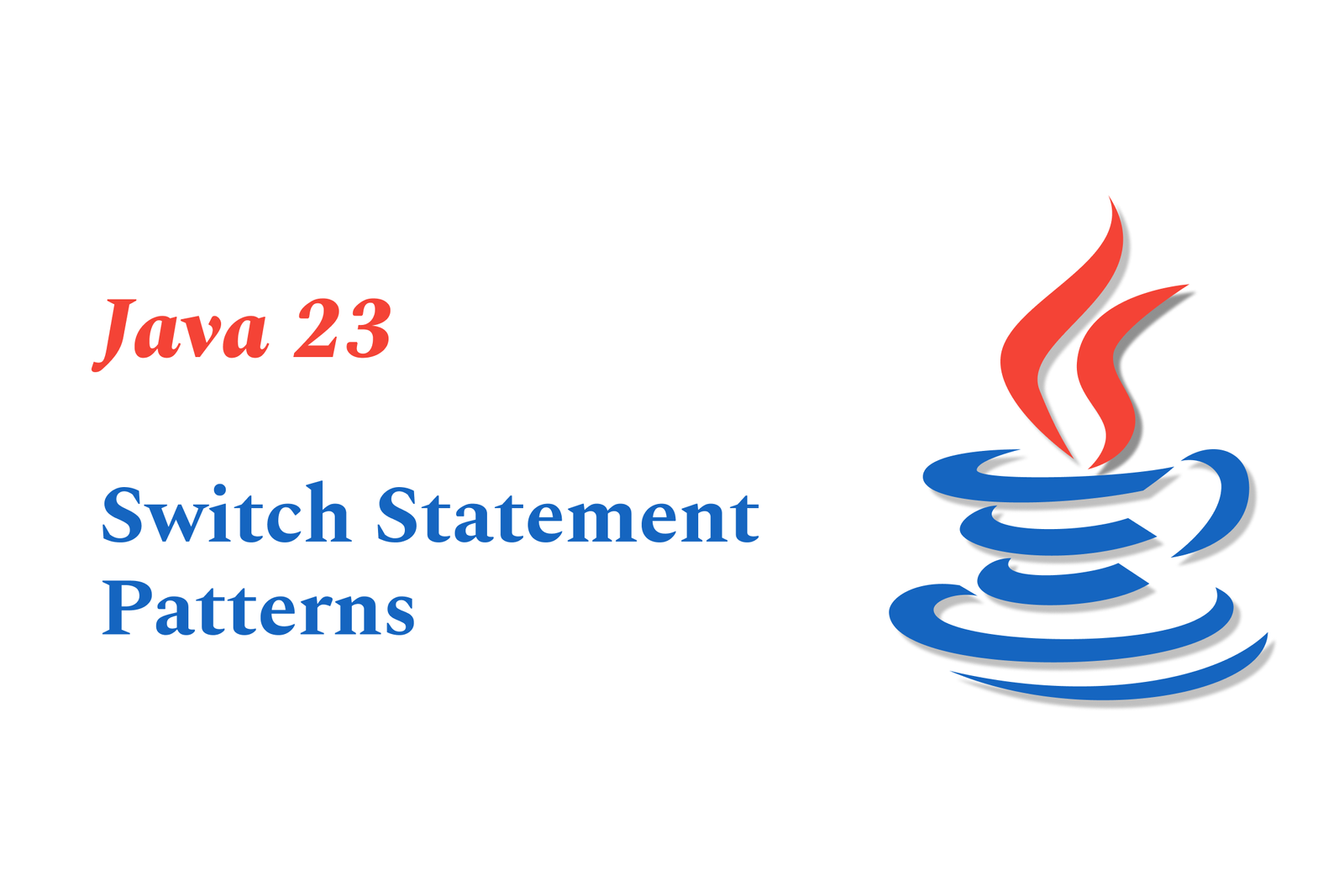Java 23 Switch Statement Patterns
Java 23 enhances switch statements with pattern matching, allowing concise, expressive type checks—including primitives—and guarded cases. This feature simplifies code by combining type testing, casting, and conditions directly within switch cases for clearer, safer control flow.
Java 23 Switch Statement Patterns
1 ) Introduction to Pattern Matching in Java
Pattern matching enhances Java's type checking and data extraction capabilities by testing an expression against specific criteria. From Java 16 onwards, type patterns simplified instanceof usage by combining type checking and casting in one step.
2 ) Evolution from if else Instanceof to Switch Patterns
Before, multiple instanceof checks required cumbersome if else chains. Switch statements with pattern matching now allow cleaner, more readable, and more performant code by matching cases on types and conditions directly.
3 ) Pattern Matching with Switch in Java 21
Java 21 introduced full support for pattern matching within switch statements and expressions, moving beyond constant value matching to sophisticated type and structure based checks. Example:
java
return switch (obj) {
case String s > s;
case Integer i > Integer.toString(i);
default > “n/a”;
};
4 ) Guarded Patterns with `when` Clauses
You can apply additional Boolean conditions to patterns in switch cases via `when` clauses to create guarded patterns, enhancing control flow precision. Example:
java
switch (obj) {
case String s when s.length() == 1 > System.out.println("Short: " + s);
case String s > System.out.println(s);
default > System.out.println("Not a string");
}
5 ) Handling Null Values in Switch Patterns
Traditional switches struggle with null selectors, but pattern matching in switch can explicitly incorporate `case null` to manage null values gracefully, improving robustness.
6 ) Primitive Patterns and Java 23 Enhancements
Java 23 introduces primitive type patterns that restore balance to the pattern matching ecosystem, enabling similar concise, expressive checks on primitives like `int`, `double`, and others in switch constructs.
7 ) Nested, Record, and Unnamed Patterns
Advanced pattern forms like nested patterns, record patterns (matching on record components), and unnamed patterns facilitate deep, structured data processing directly within switch statements.
8 ) Performance and Readability Benefits
Pattern matching in switch constructs not only clarifies intent and reduces boilerplate but also allows JVM optimizations potentially leading to O(1 ) dispatch time compared to O(n) for if else chains.
9 ) Scope and Case Dominance Rules
When using pattern variables, their scope is constrained to the matched case, and the compiler applies dominance rules to prevent unreachable patterns, enforcing cleaner code structures.
10 ) Future Directions for Pattern Matching in Java
Upcoming enhancements may include deconstruction patterns, static and instance patterns, and more powerful logical pattern combinations (AND, OR), pushing pattern matching towards a more expressive and flexible paradigm.
Summary:
Java 23's switch statement patterns represent the maturation of pattern matching in Java, extending from reference types to primitives, and enabling guarded, nested, and record based cases. This evolution simplifies code, improves performance, and sets the stage for even richer pattern mechanisms in future releases.
https://justacademy.in/news-detail/react-native?s-performance-gains-on-android-15
https://justacademy.in/news-detail/best-new-android-apps-released-this-month
https://justacademy.in/news-detail/ios-19-haptic-feedback-improvements-explored
https://justacademy.in/news-detail/top-animation-packages-for-flutter
https://justacademy.in/news-detail/java-in-blockchain-smart-contracts:-use-cases
Related Posts
Java supports GDPR and data privacy by enabling secure data handling through encryption, controlled access, and precise data management. It allows developers to minimize PII exposure, ensure data confidentiality, and design workflows that comply with data protection regulations effectively.
Java code quality tools have evolved to include advanced static analysis, integrated security checks, and AI-powered code reviews. These updates help developers detect bugs, enforce coding standards, and enhance security, streamlining the development process and improving overall code reliability.
Java remains a cornerstone in big tech companies, evolving with modern features like records, pattern matching, and virtual threads. Its robust ecosystem, enhanced performance, and growing AI integrations keep it vital for both legacy systems and innovative new projects.
Java and CI/CD pipeline optimizations streamline Java application development by automating builds, tests, and deployments. They improve efficiency through parallelization, caching, and secure secrets management, enabling faster feedback loops and more reliable, scalable software delivery.
Java supports modern cryptography standards through its flexible Java Cryptography Architecture (JCA), enabling integration of advanced algorithms like AES, EdDSA, and post-quantum tools. Libraries like Bouncy Castle offer FIPS-certified, hardware-accelerated implementations for secure development.
Java 23 enhances record patterns by enabling concise, direct destructuring of record components within pattern matching, simplifying type checks and data extraction. This improvement boosts code readability and expressiveness by reducing boilerplate in handling immutable data classes.
Java remains a top choice for mobile app backends, powering scalable, secure, and high-performance server-side solutions. Latest trends include cloud-native microservices, reactive programming, and enhanced JVM optimizations, enabling efficient, flexible, and robust mobile backend development.
Java SE 24 and LTS Java SE 21 offer enhanced features and performance, while Apache Spark 4.0.0 introduces Scala 2.13 support and advanced ML and SQL capabilities. Together, they empower developers to build scalable, high-performance data applications with modern tools.
JUnit 5 modernizes Java testing with a modular architecture, improved assertions, and seamless Java 8+ support. Beyond JUnit, tools like Mockito and AssertJ enhance mocking and assertions, creating a powerful, flexible ecosystem for writing clean, efficient Java unit tests.
Java plays a pivotal role in cloud automation tools by providing a robust, platform-independent language used to build scalable automation frameworks like Jenkins and Selenium, enabling efficient CI/CD pipelines, testing, and orchestration across diverse cloud environments.










